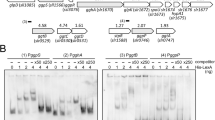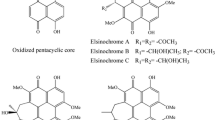Abstract
The composition of extracellular proteins is known to be drastically changed in the unicellular green alga Chlamydomonas reinhardtii when the cells are transferred from ambient CO2 to elevated CO2 conditions. We previously observed very high production of the H43/Fea1 protein under high-CO2 (0.3–3% in air) conditions. In addition, H43/Fea1 gene expression was reported to be induced under iron-deficient and cadmium-excess conditions, but it remains unclear how gene expression is regulated by multiple signals. To elucidate the regulatory mechanism of H43/Fea1 expression, this study intended to identify a high-CO2-responsive cis-element in a wall-deficient strain C. reinhardtti CC-400. Cells incubated in the presence of acetate in the dark, namely heterotrophically generated high-CO2 conditions, were used for inducing H43/Fea1 gene expression following our previous study (Hanawa et al., Plant Cell Physiol 48:299–309, 2007) in Fe-sufficient and Cd-deficient medium to prevent the generation of other signals. First, we constructed a reporter assay system using transformants constructed by introducing genes with series of 5′-deleted upstream sequences of H43/Fea1 that were fused to a coding sequence of the Ars for arylsulfatase2 reporter gene. Consequently, the high-CO2-responsive cis-element (HCRE) was found to be located at a −537/−370 upstream region from the transcriptional initiation site of H43/Fea1. However, it still remains possible that a −724/−537 upstream region may also have a significant role in activating gene expression regulated by high-CO2. Remarkably, a −925/−370 upstream region could successfully activate the Ars reporter gene under heterotrophically generated high-CO2 conditions even when the sequence containing two Fe-deficiency-responsive elements was completely deleted. These results clearly showed that H43/Fea1 expression is regulated by high-CO2 signal independently via the HCRE that is located distantly from Fe-deficient-signal responsive element, indicating that H43/Fea1 is a multi-signal-regulated gene.



Similar content being viewed by others
Abbreviations
- Ars:
-
Arylsulfatase
- CCM:
-
CO2-concentrating mechanism
- dCO2 :
-
Dissolved CO2
- DIC:
-
Dissolved inorganic carbon
- FeREs:
-
Fe-deficiency-responsive elements
- H43/Fea1:
-
High-CO2-inducible 43 kDa protein/Fe assimilation 1
- HCR:
-
High-CO2 reporter
- HCRE:
-
High-CO2-responsive cis-element
- PNP:
-
p-Nitrophenol
- PNPS:
-
p-Nitrophenyl sulfate
References
Aizawa K, Miyachi S (1986) Carbonic anhydrase and CO2 concentrating mechanisms in microalgae and cyanobacteria. FEMS Microbiol Rev 39:215–233
Allen MD, del Campo JA, Kropat J, Merchant SS (2007) FEA1, FEA2, and FRE1, encoding two homologous secreted proteins and a candidate ferrireductase, are expressed coordinately with FOX1 and FTR1 in iron-deficient Chlamydomonas reinhardtii. Eukaryotic Cell 6:1841–1852
Badger MR (1987) The CO2-concentrating mechanism in aquatic phototrophs. In: Hatch MD, Brnadman NK (eds) The biochemistry of plants: a comprehensive treatise. Vol 10, Photosynthesis. Academic Press, New York, pp 219–274
Badger MR, Kaplan A, Berry JA (1980) Internal inorganic carbon pool of Chlamydomonas reinhardtii. Evidence for a CO2 concentrating mechanism. Plant Physiol 66:407–413
Badger MR, Price GD, Long BM, Woodger FJ (2006) The environmental plasticity and ecological genomics of the cyanobacterial CO2 concentrating mechanism. J Exp Bot 57:249–265
Buyanovsky GA, Wagner GH (1983) Annual cycles of carbon dioxide level in soil air. Soil Sci Soc Am J 47:1139–1145
Church GM, Gilbert W (1984) Genomic sequencing. Proc Natl Acad Sci USA 81:1991–1995
Davies JP, Grossman AR (1994) Sequences controlling transcription of the Chlamydomonas reinhardtii β2-tubulin gene after deflagellation and during the cell cycle. Mol Cell Biol 14:5165–5174
Davies JP, Weeks DP, Grossman AR (1992) Expression of the arylsulfatase gene from the β2-tubulin promoter in Chlamydomonas reinhardtii. Nucleic Acids Res 20:2959–2965
Falkowski PG, Raven JA (2007) Aquatic photosynthesis, 2nd edn. Princeton University Press, Princeton, NJ
Fei X, Eriksson M, Yang J, Deng X (2009) An Fe deficiency responsive element with a core sequence of TGGCA regulates the expression of Fea1 in Chlamydomonas reinharditii. J Biochem 146:157–166
Fujiwara S, Ishida N, Tsuzuki M (1996) Circadian expression of the carbonic anhydrase gene, Cah1, in Chlamydomonas reinhardtii. Plant Mol Biol 32:745–749
Fukuzawa H, Fujiwara S, Yamamoto Y, Dionisio-Sese ML, Miyachi S (1990) cDNA cloning, sequence, and expression of carbonic anhydrase in Chlamydomonas reinhardtii: regulation by environmental CO2 concentration. Proc Natl Acad Sci USA 87:4383–4387
Fukuzawa H, Miura K, Ishizaki K, Kucho KI, Saito T, Kohinata T, Ohyama K (2001) Ccm1, a regulatory gene controlling the induction of a carbon-concentrating mechanism in Chlamydomonas reinhardtii by sensing CO2. Proc Natl Acad Sci USA 98:5347–5352
Giordano M, Beardall J, Raven JA (2005) CO2 concentrating mechanisms in algae: mechanisms, environmental modulation, and evolution. Annu Rev Plant Biol 56:99–131
Gorman DS, Levine RP (1965) Cytochrome f and plastocyanin: their sequence in the photosynthetic electron transport chain of Chlamydomonas reinhardi. Proc Natl Acad Sci USA 54:1665–1669
Hanawa Y, Iwamono K, Shiraiwa Y (2004) Purification of a recombinant H43, a high-CO2-inducible protein of Chlamydomonas reinhardtii, expressed in Escherichia coli. Jap J phycol 52:95–100
Hanawa Y, Watanabe M, Karatsu Y, Fukuzawa H, Shiraiwa Y (2007) Induction of a high-CO2-inducible, periplasmic protein, H43, and its application as a high-CO2-responsive marker for study of the high-CO2-sensing mechanism in Chlamydomonas reinhardtii. Plant Cell Physiol 48:299–309
Kaplan A, Reinhold L (1999) CO2 concentrating mechanisms in photosynthetic microorganisms. Annu Rev Plant Physiol Plant Mol Biol 50:539–570
Kindle KL (1990) High-frequency nuclear transformation of Chlamydomonas reinhardtii. Proc Natl Acad Sci USA 87:1228–1232
Kobayashi H, Odani S, Shiraiwa Y (1997) A high-CO2-inducible, periplasmic polypeptide in a unicellular green alga Chlamydomonas reinhardtii. Plant Physiol 114:S112
Kohinata T, Nishino H, Fukuzawa H (2008) Significance of zinc in a regulatory protein, CCM1, which regulates the carbon-concentrating mechanism in Chlamydomonas reinhardtii. Plant Cell Physiol 49:273–283
Kucho K, Yoshioka S, Taniguchi F, Ohyama K, Fukuzawa H (2003) Cis-acting elements and DNA-binding proteins involved in CO2-responsive transcriptional activation of Cah1 encoding a periplasmic carbonic anhydrase in Chlamydomonas reinhardtii. Plant Physiol 133:783–793
Lien T, Schreiner O (1975) Purification of a derepressible arylsulfatase from Chlamydomonas reinhardtii. Biochim Biophys Acta 384:168–179
Miura K, Yamano T, Yoshioka S, Kohinata T, Inoue Y, Taniguchi F, Asamizu E, Nakamura Y, Tabata S, Yamato KT, Ohyama K, Fukuzawa H (2004) Expression profiling-based identification of CO2-responsive genes regulated by CCM1 controlling a carbon-concentrating mechanism in Chlamydomonas reinhardtii. Plant Physiol 135:1595–1607
Miyachi S, Iwasaki I, Shiraiwa Y (2003) Historical perspective on microalgal and cyanobacterial acclimation to low- and extremely high-CO2 conditions. Photosynth Res 77:139–153
Molnar A, Bassett A, Thuenemann E, Schwach F, Karkare S, Ossowski S, Weigel D, Baulcombe D (2009) Highly specific gene silencing by artificial microRNAs in the unicellular alga Chlamydomonas reinhardtii. Plant J 58:165–174
Moroney JV, Ynalvez RA (2007) A proposed carbon dioxide concentration mechanism in Chlamydomonas reinhardtii. Eukaryotic Cell 6:1251–1259
Ohresser M, Matagne RF, Loppes R (1997) Expression of the arylsulphatase reporter gene under the control of the nit1 promoter in Chlamydomonas reinhardtii. Curr Genet 31:264–271
Raven JA, Cockell CS, De La Rocha CL (2008) The evolution of inorganic carbon concentrating mechanisms in photosynthesis. Philos Trans R Soc Lond B Biol Sci 363:2641–2650
Rubinelli P, Siripornadulsil S, Gao-Rubinelli F, Sayre RT (2002) Cadmium- and iron-stress-inducible gene expression in the green alga Chlamydomonas reinhardtii: evidence for H43 protein function in iron assimilation. Planta 215:1–13
Sasaki T, Kurano N, Miyachi S (1998) Induction of ferric reductase activity and of iron uptake capacity in Chlorococcum littorale cells under extremely high-CO2 and iron-deficient conditions. Plant Cell Physiol 39:405–410
Soupene E, Inwood W, Kustu S (2004) Lack of the Rhesus protein Rh1 impairs growth of the green alga Chlamydomonas reinhardtii at high CO2. Proc Natl Acad Sci USA 101:7787–7792
Spalding MH (2008) Microalgal carbon-dioxide-concentrating mechanisms: Chlamydomonas inorganic carbon transporters. J Exp Bot 59:1463–1473
Stolzy LH (1974) Soil atmosphere. In: Carson EW (ed) The plant root and its environment. University Press of Virginia, Charlottesville, pp 335–362
Sueoka N (1960) Mitotic replication of deoxyribonucleic acid in Chlamydomonas reinhardi. Proc Natl Acad Sci USA 46:83–91
Xiang Y, Zhang J, Weeks DP (2001) The Cia5 gene controls formation of the carbon concentrating mechanism in Chlamydomonas reinhardtii. Proc Natl Acad Sci USA 98:5341–5346
Yamano T, Fukuzawa H (2009) Carbon-concentrating mechanism in a green alga, Chlamydomonas reinhardtii, revealed by transcriptome analyses. J Basic Microbiol 49:42–51
Yamano T, Miura K, Fukuzawa H (2008) Expression analysis of genes associated with the induction of the carbon-concentrating mechanism in Chlamydomonas reinhardtii. Plant Physiol 147:340–354
Yoshioka S, Taniguchi F, Miura K, Inoue T, Yamano T, Fukuzawa H (2004) The novel Myb transcription factor LCR1 regulates the CO2-responsive gene Cah1, encoding a periplasmic carbonic anhydrase in Chlamydomonas reinhardtii. Plant Cell 16:1466–1477
Zorin B, Hegemann P, Sizova I (2005) Nuclear-Gene Targeting by Using Single-Stranded DNA Avoids Illegitimate DNA Integration in Chlamydomonas reinhardtii. Eukaryotic Cell 4:1264–1272
Acknowledgments
The authors are grateful to Dr. I. Sizova of St. Peterburg State University, Russia and Dr. P. Hegemann of Humboldt University, Germany for their kind gift of pSI103 (aphVIII).
Author information
Authors and Affiliations
Corresponding author
Rights and permissions
About this article
Cite this article
Baba, M., Hanawa, Y., Suzuki, I. et al. Regulation of the expression of H43/Fea1 by multi-signals. Photosynth Res 109, 169–177 (2011). https://doi.org/10.1007/s11120-010-9619-8
Received:
Accepted:
Published:
Issue Date:
DOI: https://doi.org/10.1007/s11120-010-9619-8




